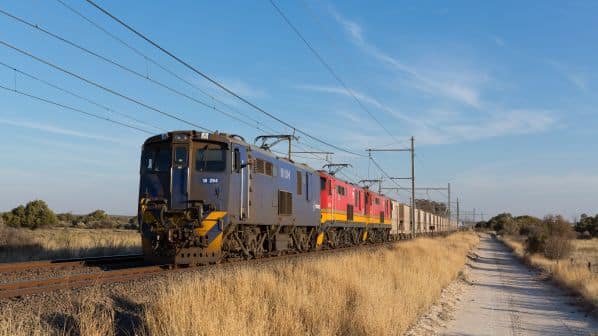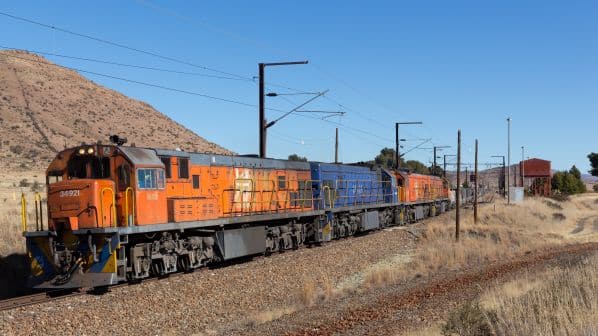THE last 10 years has seen the decimation of South Africa’s rail industry, with suppliers, manufacturers, and infrastructure whittled down, leaving end customers no choice but to move back to road, to the detriment of the South African economy. There is large potential for rail, however.
The African Rail Industry Association (ARIA) estimates that 58 million tonnes of freight would immediately move to rail when third-party access to the rail freight network is finally implemented, while Stellenbosch University estimates this could be closer to 73 million tonnes.
Three key policy elements have set the stage for this intended rail revolution.
On October 15 2020, South African president, Mr Cyril Ramaphosa, announced a post Covid-19 Economic Recovery Plan. This was essentially the precursor to the official launch of Operation Vulindlela in 2021, a joint initiative of the presidency and national treasury to accelerate the implementation of structural reforms and to support economic recovery.
Freight and passenger rail transport plays a primary role in this plan, specifically the introduction of open access to Transnet’s core freight network within 10 months under which third-party operators pay an access fee to Transnet as the owner of the infrastructure. “This will enable massive new investment in rail freight by private companies, and will increase the volume of goods that can be transported via rail instead of roads,” the government says. “This will in turn reduce congestion on major highways and improve road conditions.”
Rail policy
The National Rail Policy, which was approved by cabinet in March 2022 and gazetted on May 12 2022, intends to place rail as the backbone of a seamlessly integrated transport value chain that makes a meaningful contribution to the economy. In addition, it creates policy certainty and drives impetus to radical structural reforms within the sector.
The calls for open access have been led by industry, who have pointed out that no additional policy or regulation would be required to allow third-party access to the rail network. Transnet simply needed to allow it, and the railway is already in some ways granting third-party access to commuter operator Passenger Rail Agency of South Africa (Prasa) and the Rovos Rail tourist train.
While experience from Europe and other parts of Africa show that open access is not new, Transnet, seems intent on reinventing the wheel by creating its own open-access framework.
On October 3 2022, South African minister of transport, Mr Fikile Mbalula, announced that the National Assembly had passed the Economic Regulation of Transport Bill, which leads to the establishment of the Transport Economic Regulator, a key step to ensuring fair, competitive and transparent freight rates. This will allow the government to consolidate, rationalise and, where necessary, redesign economic regulation in the transport sector to create a single regulator for several modes.
It is no secret that South Africa’s railway infrastructure is in a sorry state.
“Until now, we have had pockets of economic regulation, fragmented along modal lines,” Mbalula says. “It is for this reason that economic functions of some of our entities will be transferred to the new regulator. The implementation of this economic regulatory model will enable us to achieve competitiveness of the sector across modes. It is equally an important enabler of private-sector participation and third-party access in our rail and maritime sectors.”
But instead of following the process laid out in the newly announced National Rail Policy, whereby access is granted to those holding permits issued by the Railway Safety Regulator (RSR), Transnet has opted instead to issue paths (or slots as Transnet is calling them) via a tender process.
The railway hosted an initial path sale information session on April 8 2022, just before the National Rail Policy was officially released, which highlighted serious issues, most relating to the lack of alignment with the National Rail Policy.
The introduction of open-access operation has been split into three phases:
- Phase 1: existing paths on the Cape Corridor from Springfontein to East London, the Container Corridor from Durban to the City Deep terminal in Johannesburg, and branch line concessionaires’ access to ports
- Phase 2: expanded paths on the container corridor, Kroonstad - Bethlehem cluster and East London route
- Phase 3: other low-density, industrial networks.
Phase 1 is to be trialled over a 24-month period between 2022 and 2024. According to Transnet, the Cape and Container corridors are key for South Africa’s main growth sectors, particularly manufacturing, the automotive industry and agriculture.
The new system will see Transnet Freight Rail (TFR) retain ownership of the infrastructure.
Transnet announced on November 25 that it has conditionally awarded Traxtion Sheltam paths to operate services on the Cape Corridor, after it successfully completed Stage 1 of the evaluation process for the route.
The company will now be required to complete the rest of the application process, which includes meeting the requirements of the Rail Safety Regulator and other operational readiness requirements specified by Transnet. Once Stage 2 has been completed, Traxtion Sheltam will enter into final negotiations with a view to commencing operation in the 2023-24 financial year.
Transnet reports that 19 potential bidders expressed interest in the 16 paths that were offered to the private sector earlier this year. By the close of the application process on August 31, Transnet had received applications from two companies expressing interest in the Container Corridor, with one also considering the Cape Corridor.

A Transnet media release said that neither applicant met the Stage 1 evaluation criteria for the Container Corridor, where electric locomotives are required for freight operations. However, the Cape Corridor application made by Traxtion Sheltam was successful.
Numerous issues with third-party open access have emerged and the rail industry, through the African Rail Industry Association (ARIA), has been extremely vocal about the shortcomings of the process.
Firstly, going to market on April 1 2022, prior to the National Rail Policy being gazetted in early May 2022, has been interpreted as a strategic move that avoids full compliance with the policy, which defines open access as access to any part of Transnet’s network, excluding heavy-haul lines.
Transnet CEO, Ms Portia Derby, appeared to confirm these fears in her presentation to the South African Railway Association (SARA) conference in October 2022.
“The Department of Transport (DoT) clarified that the National Rail Policy is not yet enacted into law in South Africa and therefore there is no risk of non-compliance for TFR by implementing path sales in Phase 1 as this phase is within the current legislative environment,” Derby says. “The DoT acknowledged that path sales are an independent initiative by Transnet, which they welcomed, as it will enable policy makers to derive shared learnings that will inform implementation post 2024, once the enablers are in place.”
Infrastructure constraints are another issue to the successful implementation of open access.
It is no secret that South Africa’s railway infrastructure is in a sorry state. The lack of proper track maintenance, financial constraints on maintenance spend, and the theft and vandalism of track, overhead electrification and signalling has had a negative impact on Transnet operations.
It will also have the same dire consequences for private operators subjected to the same challenges without recourse, especially in the absence of an established regulator and a vertically-separated Transnet that remains both a freight operator and infrastructure manager.
Questions remain over what happens when a train cannot run to schedule, or in the event of a track or train failure. This process has been outlined within the National Rail Policy, but Transnet has adopted a “voetstoots” approach. A South African legal term, voetstoots or “as is condition” removes the responsibility of the provider in the event of a fault or failure, essentially removing accountability and risk from Transnet.
Rolling stock
The availability of rolling stock is also a constraint. There is little additional capacity among local operators, which are generally operating successfully within Africa and in local closed mining operations. In addition, private operators and local leasing companies do not have electric locomotives in their fleets, which are required for operating the Gauteng - Durban route.
One could argue that these operators could import additional rolling stock, but this is not a simple process as South Africa prohibits the import of second-hand locomotives while purchasing new locomotives requires such a long lead time that the pilot phase will have passed by the time they arrive.
There could also be a limit to the availability of funding for the purchase of new rolling stock, with the pilot phase only running for two years and no policy certainty beyond this period.
It is somewhat ironic that the lack of rolling stock availability is also the excuse given by Transnet over the last year as to why it has struggled to meet customer demand. However, in a bold move to apparently support new entrants, Transnet Engineering has been given approval to open a locomotive and wagon leasing company.
An additional issue is the requirement that private operators should be a member of Transnet’s Bargaining Council, the body through which Transnet negotiates with its staff, could counteract the advantages that private businesses have in negotiating with staff, especially as the private sector already has representation with their nominated labour union. It is not practical to have both.
Transnet is reserving its grandfather rights as the dominant rail operator, an exemption that allows it to continue with operations that were approved before the implementation of new rules, regulations or laws.
This implies that as TFR was operating before open access was granted, it can continue doing as it pleases without having to adhere to the new operating model. Not only is this anti-competitive, but it could be seen to discriminate against new entrants, especially as TFR would be the network owner, network manager and dominant operator.
The National Rail Policy states that rates and the terms of business should be published in the public domain, but this is also yet to happen and it is currently not publicly known what the rates will be.
“There is a way to go before this becomes a reality but in principle we are looking forward to working with Transnet to achieve the goal of true private third-party access to the rail freight network,” the CEO of Traxtion, Mr James Holley, noted in a media statement following the announcement that Traxtion has been successful in their bid.
The announcement of open access was a chance to rejuvenate South Africa’s rail freight sector. But if Transnet decides to go it alone, without working with the government, the system could miss out on some of the promised benefits.

